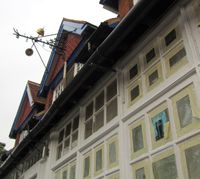Key:disused
 |
| Description |
|---|
| Specifies if a feature is disused but in a reasonable state of repair. |
| Group: lifecycle |
| Used on these elements |
| Documented values: 1 |
| See also |
|
| Status: approved |
| Tools for this tag |
|
The tag disused=yes is a property that is added to features that are in a reasonable state of repair but which are currently unused. It makes sense to use it in case when being "unused" does not negate a feature's primary function. Examples include vacant buildings, disused communications towers, and quarries without active mining, and most man_made features: these do not cease to be significant as orientation landmarks when they are not being used.
Use of disused=yes is discouraged for features like shops, roads, parks or museums. See the namespace prefix disused:*=* instead, for example disused:amenity=*, disused:leisure=*, disused:tourism=*.
For features which can only be returned to use with significant repair efforts, use the tag abandoned or the namespace abandoned:*=* instead.
How to map
- A simple feature such as an Tag:man_made=adit which is in good condition but is not used is tagged with
man_made=adit+disused=yes.
Examples:
- disused quarries should be tagged
landuse=quarry+disused=yes, not withdisused:landuse=quarry. The difference is thatshop=*describes only active shops (where you may buy things or services) whilelanduse=quarrydescribes type of landscape, not a company operating there. The same applies to building=*man_made=adit
disused:*=* namespace
Any tags which no longer have current meaning as a result of disuse should had their keys prefixed with the namespace disused:*=* — see the examples below. This makes it clear that they are not useful features.
Add the namespace disused:*=* as a prefix to all keys which are no longer relevant to the current state of an object. You should treat all the tags on an object as a set of facts about the object, and prefix the keys of those facts which are no longer true as a result of the disuse. For example, a concrete parking area which is no longer used for parking cars but which still carries a name sign might be tagged as
which makes it unavailable to programs which find parking, and unlikely to be displayed as parking in any default renderings. The name is still relevant, and will still be searchable. If the area is opened up again, it's a simple matter to undo the prefixing.
Comparison of disused=yes vs disused:key=* namespace
| Original scheme (not recommended) | Intermediate scheme (discouraged) | Recommended |
|---|---|---|
| amenity=pub disused=yes |
disused:amenity=pub disused=yes |
disused:amenity=pub |
| amenity=parking capacity=20 disused=yes |
disused:amenity=parking disused:capacity=20 disused=yes |
disused:amenity=parking disused:capacity=20 |
Disused railways
Disused rail lines have a special method of tagging which is in use:
This tagging scheme is equivalent in meaning to using :disused prefix and is more popular among mappers.
See also
railway- special tag for disused railways, no longer used by trains but the rails remain in place.disused:*=*- Namespace for features that have fallen into disuse, but which are still useful for navigation and visible in the landscapeabandoned:*=*- Namespace for features that have been abandoned by their owner, but which are still useful for navigation and visible in the landscape. Immediate reuse is not planned, and they may have fallen into disrepairabandoned- A man-made feature abandoned and no longer maintained. Also seeabandoned:*=*shop=vacant- Shop that is currently not being usedopening_hours=closed- specifies something which is currently or temporary closed- Lifecycle prefix
- Comparison of life cycle concepts, for a discussion of how to tag features through their life-cycle from proposal through operation to complete obliteration.
- mailing list discussion about valid uses for disused=yes and abandoned=yes